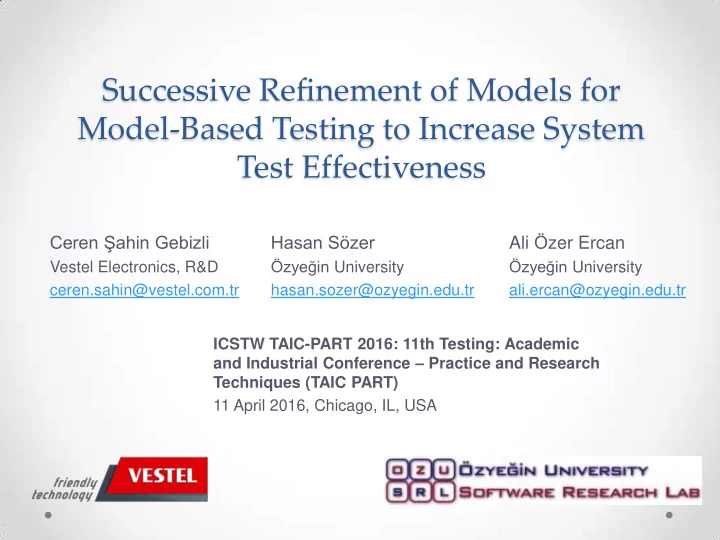

Successive Refinement of Models for Model-Based Testing to Increase System Test Effectiveness Ceren Şahin Gebizli Hasan Sözer Ali Ö zer Ercan Özyeğin University Özyeğin University Vestel Electronics, R&D ceren.sahin@vestel.com.tr hasan.sozer@ozyegin.edu.tr ali.ercan@ozyegin.edu.tr ICSTW TAIC-PART 2016: 11th Testing: Academic and Industrial Conference – Practice and Research Techniques (TAIC PART) 11 April 2016, Chicago, IL, USA
Outline • Testing Challenges in Consumer Electronics Domain • Model-based Testing and System Models • Overall Approach • Model Updates and Case Study • Results and Future Work 2
Challenges • Short time-to-market • Limited resources • Large code base 5M LOC in total o • Large models Thousands of states and transitions o • Importance of User Perception 3
Model-based Testing (MBT) Automated test case generation based on models that represent the desired behavior of the system under test (SUT) Test Cases Test Model A,E,B,A,E A,E,B,A,E B MBT A,E,B,C,D A A,E,B,C,D C,D,E,B,A C,D,E,B,A C Tool C,A,E,B,A E C,A,E,B,A D ... ... Effective test case generation; Focus on features that are mostly used • Focus on scenarios that are mostly error-prone • Focus on scenarios that reveal different failures • 4
System Models used for MBT start state transition probabilities finish state states that can comprise sub- models Hierarchical Markov chains defined with the MaTeLo tool (http://www.all4tec.net) 5
Overall Approach • Update system models based on; o Frequency of usage by the end-users o Estimated risk of failure based on static analysis o Estimated risk of failure based on dynamic analysis • (Re)generate and execute test cases 6
System Model Updates • First assignments of transition probabilities based on number of visits recorded in the usage profile v 0 t i v 1 s . . • Next: second & third updates . based on estimated risk of error v n- 1 7
Update based on Risk of Error • Risk estimations: • Static analysis: Ratio of static code analysis alerts • Dynamic analysis: Ratio of memory leaks • Example: Update of the system model after the probability of error for state s is calculated as 0.2 8
Industrial Case Study Initial model was previously developed by the software test group in • the company. Data Collection and Estimations; Usage Profile • Static Analysis* • Memory Profile • 9 * Performed with the Klockwork tool (http://www.klocwork.com/)
Model Updates 10
Iterations 11
Results and Future Work • Reduction in the number of test cases • Detection of new faults • Different types of fault/error states • Test execution time vs. fault detection trade-off • Eliminating iterations • Updating only once by aggregating estimations 12
Conclusions • Challenging context of the consumer electronics domain • Testing focus on mostly used, error-prone scenarios • An iterative model refinement approach • Detection of new faults in each iteration 13
Thanks! Questions welcome.. 14
Recommend
More recommend